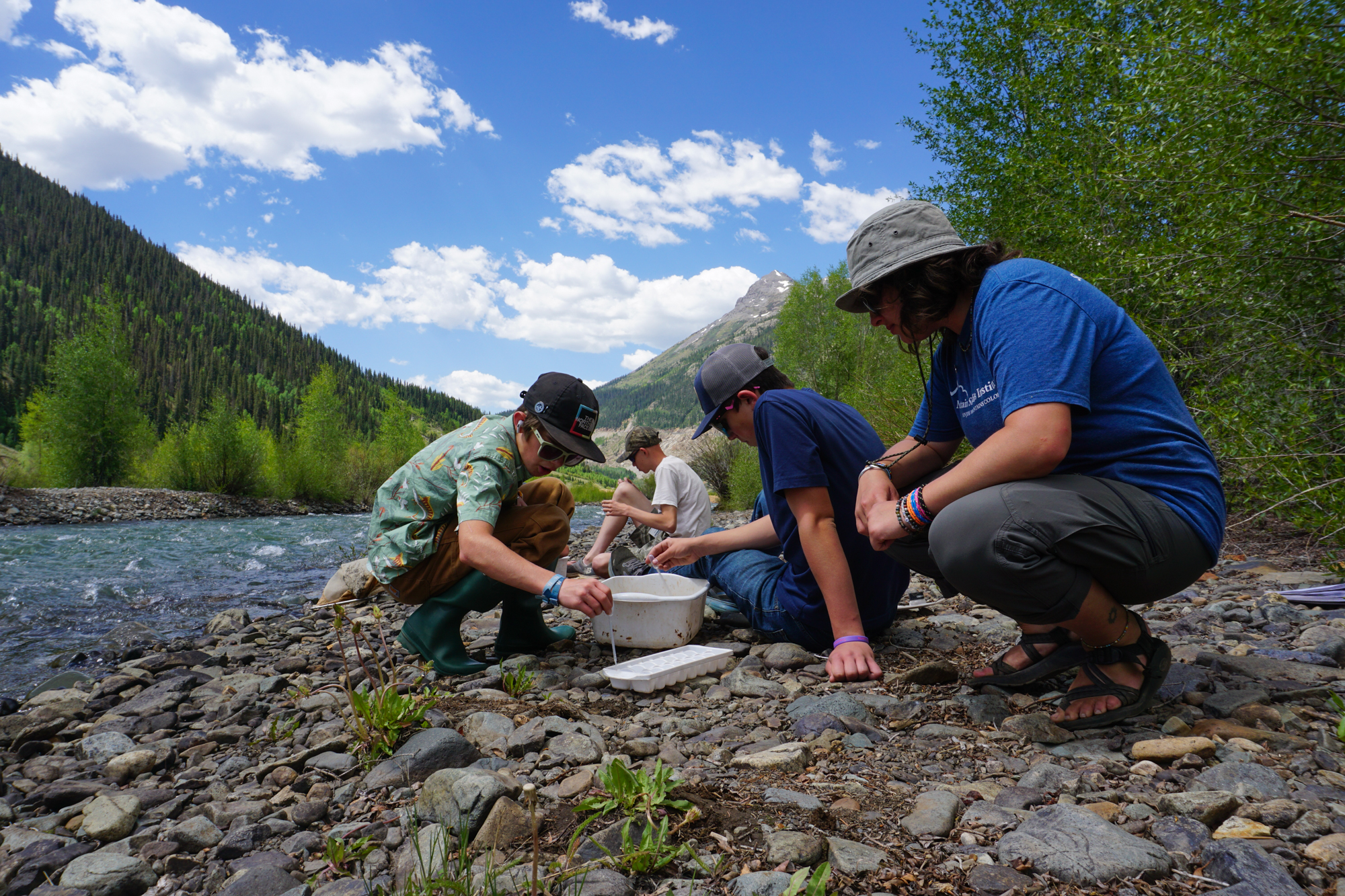In rural Colorado, school districts broke down attendance boundaries and pooled resources to prepare students for college and good jobs.
DURANGO, Colo. — For three dozen high schoolers, summer break in this southwest Colorado city kicked off with some rock climbing, mountain biking and fly-fishing.
Then, the work began.
As part of a weeklong institute on climate and the environment, mountain researchers taught the students how to mix clumps of grass seed, clay, compost and sand for seedballs that they threw into burned areas of the Hermosa Creek watershed to help with native plant recovery. The students upturned rocks — and splashed each other — along the banks of the Animas River, searching for signs of aquatic life after a disastrous mine spill. They later waded through a wetland and scouted for beaver dams as part of a lesson on how humans can support water restoration.
Each task was designed to prepare them for potential careers connected to the natural world — forest ecologist, aquatic biologist, conservationist. Many of the students had already taken college-level environmental science courses, on subjects such as pollution mitigation and water quality, at local high schools and Fort Lewis College.
Other students in and around Durango were taking a summer crash course in the health sciences, and this fall can earn college credit in classes like emergency medical services and nursing. Still others were participating in similar programs for early childhood education and for teacher preparation.
“I like the let-me-work-outside model.”
Autumn Schulz, rising sophomore, Ignacio High School
Every day this past school year, she rode a public transit bus, passing miles of high desert terrain, to take an ecology class at Bayfield High School, in another district. She’d already completed internships at a mountain research nonprofit and a public utility to explore environmental and municipal jobs in her preferred field.
“It’s my favorite subject,” she said. “It’s one of my favorite things.”
None of this would have been possible before 2020. Back then, the Bayfield, Durango and Ignacio school districts operated largely independently. But as the pandemic took hold and communities debated whether to reopen schools after lockdown, a newly formed alliance of nine rural districts in southwest Colorado attempted to extinguish their attendance boundaries and pooled staff and financial resources to help more students get into college and high-paying careers.
Across the United States, rural schools often struggle to provide the kinds of academic opportunities that students in more populous areas might take for granted. Although often the hub of their communities, rural schools tend to struggle with a shrinking teaching force, budgets spread too thin and limited access to employers who can help. Rural students have fewer options for advanced courses or career and technical education, or CTE, before entering the workforce.
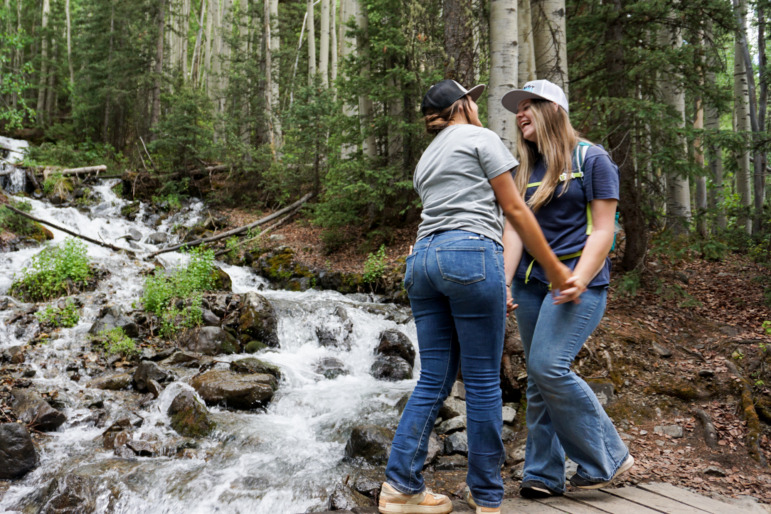
Neal Morton/The Hechinger Report
Gracie Vaughn and BreAnna Bennet, right, attend different high schools in different school districts. The teenagers roomed together during a summer program at Fort Lewis College in Durango, Colo.
But clustered near the Four Corners in Colorado, the coalition of nine rural districts has partnered with higher education and business leaders to successfully expand career and college pathways for their students. A nonprofit formed by the districts conducts job market analysis and surveys teenagers about their interests. Armed with that data, academic counselors can advise students on the array of new CTE and college-level classes in high-wage positions in the building trades, hospitality and tourism, health sciences, education and the environment.
Teachers working in classrooms separated by 100 miles or more regularly meet in-person and online to share curriculum and industry-grade equipment. More than five dozen employers in the region have created ways for students to explore careers in new fields, such as apprenticeships, job shadows and internships. And some students earn a job offer, workforce certificate or associate degree before they finish high school.
Collectively, the Southwest Colorado Education Collaborative has raised more than $7 million in private and public money to pay for these programs, and its work has inspired similar rural alliances across the state. The collaborative’s future, however, is uncertain, as federal pandemic relief funds that supported its creation soon expire. Advocates have started to campaign for a permanent funding fix and changes in state policy that would make it easier for rural schools to continue partnering with one another.
Jess Morrison, who stepped down at the end of July as the collaborative’s founding executive director, said the group — and others like it in Indiana and South Texas — demonstrates the strength of regional neighbors creating solutions of their own, together.
“It’s about our region not waiting on people to save us.”
Jess Morrison
Nationally, more than 9.5 million U.S. students — or about 1 in 5 students — attend a rural school. The National Center for Education Statistics has found that, compared with the U.S. average, students in rural schools finish high school at higher rates and even outperform their peers in cities and suburbs. But only 55 percent of rural high schoolers enroll in college, a much lower share than their urban and suburban counterparts. Rural students make less money as adults and, compared to suburban students, are more likely to grow up in poverty.
In this part of southwest Colorado, where about half of students qualify for subsidized meals at school, employers have struggled to find enough workers but also to provide a liveable wage. Hoping to steer more high schoolers into high-skill and high-wage jobs, educators and superintendents from five school districts — Archuleta, Bayfield, Durango, Ignacio and Silverton — started to meet with representatives from Fort Lewis College and Pueblo Community College. In early 2019, they began working with the nonprofits Empower Schools and Lyra Colorado to formally create a regional collaborative and visited a similar project in South Texas.
Covid briefly disrupted much of that work, but in June 2020, tapping federal relief dollars for education, Colorado Gov. Jared Polis announced a nearly $33 million fund to close equity gaps and support students affected by the pandemic. Already poised to work together, the collaborative secured the largest award — $3.6 million — from the governor’s fund to help students explore environmental science and the building trades, two areas in which the number of jobs was projected to increase.
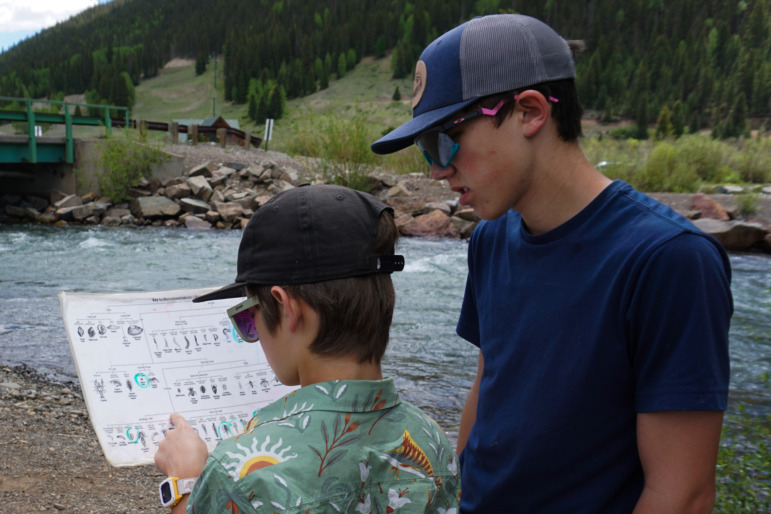
Neal Morton/The Hechinger Report
Waylon Kiddoo, left, and fellow Dolores Secondary School student Gus Vaughn, classify insects they discovered in the Animas River for an environmental climate institute offered every summer to high schoolers in southwest Colorado.
Despite that demand for workers, none of the school districts offered a single class in HVAC, electrical or plumbing, according to Morrison, nor did any of the nearby higher ed institutions. “We were a complete desert,” she said.
In 2022, the collaborative began piloting summer institutes, employers started hiring students directly from those programs and Pueblo Community College began offering electrical certification at its southwest campus. Woodworking instructors from different districts started to gather monthly, comparing lesson plans and creating wish lists for new classes and equipment. New CNC routers, laser cutters and electric planers arrived at teachers’ classrooms. Soon, teachers will pilot an HVAC course for high schoolers.
Over time, the collaborative added four additional school districts: Dolores, Dove Creek, Mancos and Montezuma Cortez. It also formally partnered with two tribal nations, Southern Ute and Ute Mountain Ute, while expanding its college and career tracks to include education, the health sciences and hospitality/tourism.
According to the collaborative’s annual report:
As of 2023, nearly 900 students across the nine districts — of about 13,000 total for the region — had participated in environmental, agriculture and outdoor recreation courses.
Approximately 325 students have completed a building trades course, with 40 so far earning industry certificates. Another 199 students finished a welding course, and 77 students also took college-level classes in that field.
Joshua Walton just finished his 11th year teaching science at Bayfield High School. He’s seen the changes firsthand: His classroom today has clinometers, game cameras and soil-testing equipment on its shelves. Walton often reserves the collaborative’s mobile learning unit, a 14-passenger van converted into a traveling science lab, so students can run experiments along the Animas River. He also prepares students to get their certification in water science.
“We’re giving students the opportunity where they can be an aquatic biologist or get a job doing water testing pretty much right after they graduate,” said Walton.
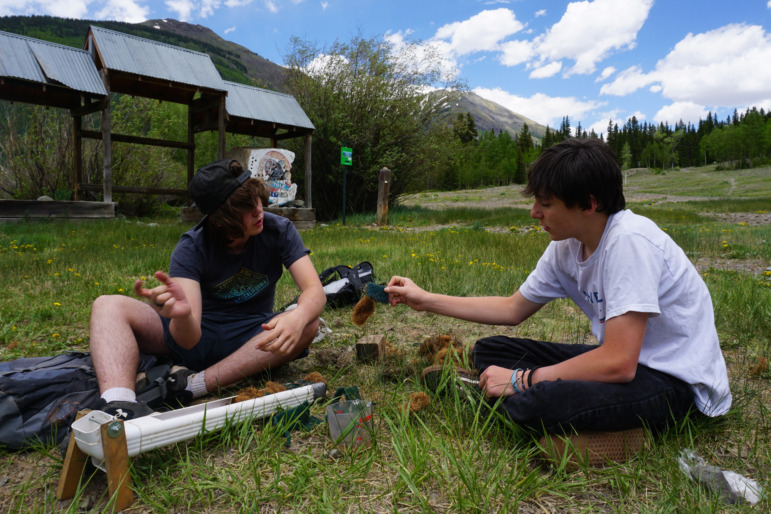
Neal Morton/The Hechinger Report
Ari Zimmerman-Bergin and James Folsom, right, use peat moss, scrubbing pads and rocks to build an experimental wetland. They studied water restoration in Silverton, Colo., as part of a field trip for students interested in environmental studies.
Tiffany Aspromonte, who works as academic advisor at Mancos High School, grew up in town and has raised her two children there. Her oldest son, a rising senior at Mancos High, regularly changes his mind about his future, she said.
He already earned a mini-certification in welding, and he’s taken courses in drones and — when he wanted to become an eye doctor — medical terminology. Now, he’s in love with hands-on engineering classes, but hates the bookwork, Aspromonte said. This fall, her son will spend Friday nights at Pueblo Community College for a wildland fire class.
“He’s not the exception,” Aspromonte said.
“Just in our small school, a lot of kids can go really in-depth so they can get an idea of what they do or don’t want to do.”
Tiffany Aspromonte, academic advisor, Mancos High School
And, she added, the rural brain drain — of ambitious students leaving a small town for college or better jobs — seems less pressing.
“There’s no pressure to leave home, unless you really want to,” Aspromonte said.
[Related: Native Americans turn to charter schools to reclaim their kids’ education]
Along the way there have been challenges. Since 2020, all but one of the founding five superintendents left their positions, reflecting the nationwide churn of school leaders during the pandemic. Deciding how to divide money among districts hasn’t always been easy, said Morrison, the collaborative’s former director.
Student enrollment in shared courses never reached a point that would justify added costs, such as transportation. This fall, the alliance will limit the classes that high schoolers can take across district lines to education and health sciences. (Students can still take the courses in the building trades, environment and hospitality/tourism in their own high schools and at the local colleges. Each track will continue to include work-based learning.)
“We needed to simplify our approach,” Morrison said. “We started grand with all five pathways across all nine districts.”
And working with local business leaders has at times been challenging too, said Patrick Fredricks, the collaborative’s deputy director. Employers often want to give students tours of their businesses but, with the collaborative’s nudging, they can create real-world lessons: A popular bar and grill in Cortez reopened on a day off so students could host a pop-up restaurant. Dove Creek schools sent 20 kids to practice with staple guns and X-ray machines in the paramedic wing of the regional hospital.
Today, the collaborative regularly hosts career fairs with local businesses, matches students with employers to shadow on half-day visits to the workplace and helps arrange longer-term internships as well.
Last school year, more than 200 students shadowed business leaders at 16 different job sites, including the local hospital, ski resorts and a cattle ranch.
The Colorado Education Initiative, a Denver-based nonprofit, has studied the impact of the pandemic relief money on students and plans to release initial findings this fall. In an early review of the data, released last November, the nonprofit found that projects funded by the governor’s office, including those of the collaborative, generally improved academic and social emotional outcomes.
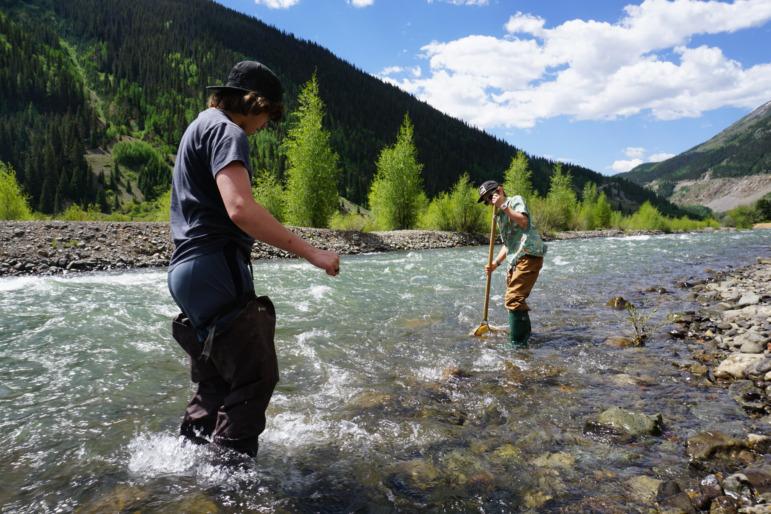
Neal Morton/The Hechinger Report
Ari Zimmerman-Bergin, left, and Waylon Kiddoo, both students at Dolores Secondary School, kick through rocks to look for signs of aquatic life in the Animas River.
The collaborative model has started to spread. Three remote districts in eastern Indiana recently created a “rural alliance zone” to get students into IT, advanced manufacturing, marketing and other career clusters. Last year, the Texas legislature overwhelmingly approved the creation of an annual $5 million pot of money to incentivize the creation of rural alliances in that state.
[Related: Q&A: Why this Memphis ELA teacher helped his students start a farmer’s market]
Back in Colorado, political allies of the collaborative have pitched the idea of dedicating state money for such partnerships or reducing the amount of bureaucracy and paperwork needed to share funds among school districts. Eric Maruyama, spokesman for Gov. Polis, said in a statement that the Colorado governor “is committed to creating educational opportunities that give students the skills needed to thrive and fill in-demand jobs” but declined to say if he would take specific action.
Taylor McCabe-Juhnke, is the executive director of the Rural Schools Collaborative, a national network that operates in more than 30 states.
She’s optimistic that successful partnerships in rural communities like southwest Colorado will convince philanthropic and public funders to invest.
“It’s not very sexy to fund or make time and space for relationship building,” she said. “It’s also the right thing to do to benefit broader rural community vitality.”
In Silverton, an old mining town near the headwaters of the Rio Grande, kayakers called to the students sitting on rocks along banks of the Animas River. The teenagers circled around ice trays brimming with river water and tried to classify the swimming macroinvertebrates.
[Related: MIT, Yale and other elite colleges are finally reaching out to rural students]
“Is that one squiggly like a worm?” BreAnna Bennet, a rising senior from Durango High School, asked her group.
At the start of the summer program, Bennet said she had no desire to do any job in the outdoors. By the third day, she often tailed the instructor and supplied a stream of questions about wetland restoration efforts and wildlife in the backcountry.
“This is fun. I like this,” Bennet said, looking up from the ice tray. “Your activity is my favorite so far.”
***
Neal Morton is a reporter for The Hechinger Report. He covers K-12 schools in Arizona, Colorado, Idaho, Montana, New Mexico, Nevada, Oregon, Utah, Washington and Wyoming. He most recently worked with the Education Lab team at The Seattle Times, and previously covered education for The Las Vegas Review-Journal in Nevada and The (McAllen) Monitor in Texas. His work has appeared in High Country News, Huffington Post, PBS NewsHour, USA TODAY and local media outlets.
This story about Colorado rural schools alliances was produced by The Hechinger Report, a nonprofit, independent news organization focused on inequality and innovation in education. Sign up for the Hechinger newsletter.
This story also appeared in Chalkbeat and High Country News.


